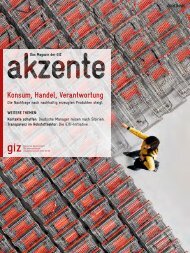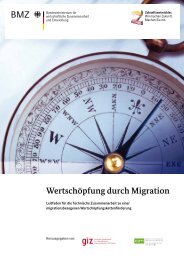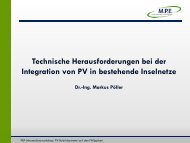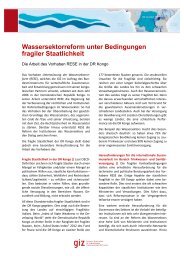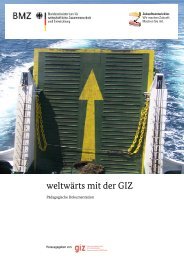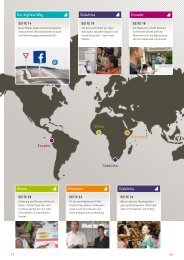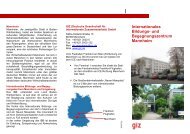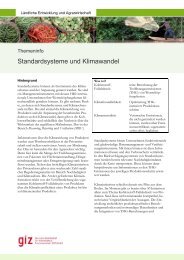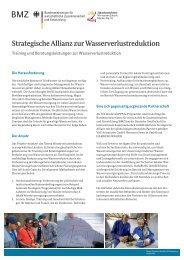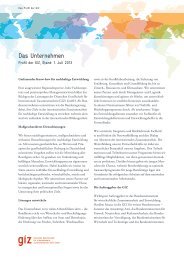Innovation Ecosystem: Cooperation Matters! - GIZ
Innovation Ecosystem: Cooperation Matters! - GIZ
Innovation Ecosystem: Cooperation Matters! - GIZ
You also want an ePaper? Increase the reach of your titles
YUMPU automatically turns print PDFs into web optimized ePapers that Google loves.
nd<br />
2 MSME Summit<br />
Theme: “<strong>Innovation</strong> – An Imperative for<br />
Competitiveness & Sustainable Development”<br />
th<br />
14 March 2013, New Delhi<br />
<strong>Innovation</strong> <strong>Ecosystem</strong>: <strong>Cooperation</strong> <strong>Matters</strong>!<br />
The case of the SME, Cluster and Automotive<br />
Industry in German System
Published by:<br />
MSME Umbrella Programme<br />
Deutsche Gesellschaft fur Internationale<br />
Zusammenarbeit(<strong>GIZ</strong>) Gmbh<br />
B5/1, Safdarjung Encalve, New Delhi 110029<br />
India<br />
Tel: +91-11-49495353<br />
Fax:+91-11-49495391<br />
Email: amit.kumar@giz.de, stefanie.bauer@giz.de<br />
New Delhi, March 2013
<strong>Innovation</strong> <strong>Ecosystem</strong>: <strong>Cooperation</strong> <strong>Matters</strong>!<br />
<strong>Innovation</strong> is a key driver of long-term economic growth and competitiveness: it plays a<br />
crucial role in increasing productivity and developing higher quality products and<br />
services and in diversifying economies and markets. Empirics show that companies that<br />
have a record of successful innovation usually enjoy major competitive advantages,<br />
which is also reflected in a higher firm value.<br />
Strengthening a countries' innovation system – namely, the interaction between actors<br />
involved in the innovation process as well as the institutions and the framework<br />
conditions that shape their actions and their relationships with each other – thus has<br />
become crucial for sustained economic development. <strong>Innovation</strong>, as it is commonly used<br />
in economics, hereby describes the commercially successful introduction or<br />
implementation of a product, process or organizational novelty. Or, following the often<br />
quoted German economist Joseph Schumpeter, innovation can as well be a new<br />
combination of existing knowledge. However, it needs to be clarified that an innovation is<br />
not only what is “new to the world” but also what is new to the country or firm. In short, an<br />
innovation is a product or process which is new to the context.<br />
This paper deals with the <strong>Innovation</strong> <strong>Ecosystem</strong> and German <strong>Innovation</strong> Policy and its<br />
Governance, with special focus on clusters and the promotion of the German SME sector,<br />
the so-called “German Mittelstand”. Citing the case of the German Automotive Industry,<br />
instruments and mechanisms of innovation system promotion are demonstrated in two<br />
practical successful examples, namely “Light-e-body”, a nationwide cooperation of<br />
various shareholders and stakeholders for the development of a new lightweight electro<br />
mobility car body, and the case of the Stuttgart Region Automotive cluster, with its wellknown<br />
representatives Daimler and Porsche.<br />
While for a long time, governments have focused on promoting research and<br />
development institutions, it is now being acknowledged that innovation is a result of<br />
interaction between different actors: research institutions only being one group of actors.<br />
Governments therefore today need to invest in strengthening their countries' innovation<br />
systems. Identification of key actors, the promotion of their interaction, interlinkages and<br />
cooperation and favorable framework conditions are essential for successful<br />
innovations. Above all, in the case of a successful innovation system institutions matter<br />
– yet, cooperation matters even more.
Deutsche Gesellschaft fur Internationale Zusammearbeit Gmbh (<strong>GIZ</strong>)<br />
The services delivered by the Deutsche Gesellschaft für Internationale Zusammenarbeit (<strong>GIZ</strong>)<br />
GmbH draw on a wealth of regional and technical expertise and tried and tested management<br />
know-how. As a federal enterprise, we support the German Government in achieving its objectives<br />
in the field of international cooperation for sustainable development. We offer demand-driven,<br />
tailor-made and effective services for sustainable development.<br />
When providing its advisory services in the field of innovation, <strong>GIZ</strong> draws on its cooperation<br />
network consisting of scientific, professional and research institutions and of implementing<br />
organizations of the German Federal Ministry for Economic <strong>Cooperation</strong> and Development (BMZ),<br />
the German Federal Ministry of Education and Research (BMBF) and the German Federal Ministry of<br />
Economics and Technology (BMWi). Its presence in the field ensures that <strong>GIZ</strong> has access to the<br />
relevant political, scientific, academic and business institutions, and an insight into the special<br />
features of the political and institutional environment.<br />
Our range of advisory services is geared to the National <strong>Innovation</strong> Systems (NIS) approach. It aims<br />
to facilitate the transition from economic systems based on factors of production to knowledgebased<br />
systems. We advise on designing an approach to innovation promotion that combines<br />
political, strategic and instrumental aspects.<br />
Website: www.giz.de<br />
Automotive Component Manufacturers Association of India<br />
The Automotive Component Manufacturers Association of India (ACMA) is the apex body<br />
representing the interest of the Indian Auto Component Industry. Its active involvement in trade<br />
promotion, technology up-gradation, quality enhancement and collection and dissemination of<br />
information has made it a vital catalyst for this industry's development. Its other activities include<br />
participation in international trade fairs, sending trade delegations overseas and bringing out<br />
publications on various subjects related to the automotive industry.<br />
ACMA's charter is to develop a globally competitive Indian Auto Component Industry and<br />
strengthen its role in national economic development as also promote business through<br />
international alliances. ACMA is represented on a number of panels, committees and councils of<br />
the Government of India through which it helps in the formulation of policies pertaining to the<br />
Indian automotive industry.<br />
For Exchange of Information and especially for co-operation in trade matters, ACMA has signed<br />
Memoranda of Understanding with its counterparts in Australia, Brazil, Canada, Egypt, France,<br />
Germany, Iran, Italy, Japan, Malaysia, Pakistan, South Africa, South Korea, Spain, Sweden, Thailand,<br />
Tunisia, Turkey, UK, USA and Uzbekistan.<br />
ACMA represents over 670 companies, which contributes more than 85% of the total auto<br />
component output in the organised sector. In the domestic market, they supply components to<br />
vehicle manufacturers as original equipment, to tier-one suppliers, to state transport<br />
undertakings, defence establishments, railways and even to the replacement market. A variety of<br />
components are being exported to OEM's and after-markets world-wide. ACMA is inseparably<br />
linked with the auto component sector and hence forms the channel through which business<br />
contacts are established with the Indian Automotive Industry.<br />
Website: www.acma.in
Table of Content<br />
1 Institutions matter! - The Concept of the National <strong>Innovation</strong> System 6<br />
1.1 Introduction 6<br />
1.2 Promoting <strong>Innovation</strong> Systems – An Approach 7<br />
1.3 German <strong>Innovation</strong> System as a "Role Model" 10<br />
2 German "Mittelstand", Clusters and <strong>Innovation</strong> 14<br />
2.1 Promotion of <strong>Innovation</strong> and Competitiveness of the 14<br />
"German Mittelstand"<br />
2.2 Cluster: Small System of <strong>Innovation</strong> 15<br />
3 The Case of the German Automotive Industry 17<br />
3.1 Specifics of the German Automotive Industry 17<br />
3.2 Example 1: The Nationwide Project "Light eBody" 19<br />
3.3 Example 2: Stuttgart Region Automotive Cluster 21<br />
4 Learnings for <strong>Innovation</strong> Promotion System for Indian SME 23<br />
References 26<br />
Table of Figures<br />
Figure 1: Different Ways to Stimulate an <strong>Innovation</strong> System 9<br />
Figure 2: R&D Expenditure of Different Actors in Germany 11<br />
Figure 3: Actors at Different Levels of the German <strong>Innovation</strong> System 13<br />
Figure 4: Different Quantitative Definitions of the „German Mittelstand“ 14<br />
Figure 5: Categories of Services Provided by Cluster Management Organizations 16<br />
Figure 6: Cluster as a Sub System of National <strong>Innovation</strong> System (source VDI) 24
Institutions Matter!<br />
The Concept of the<br />
National <strong>Innovation</strong> System<br />
1.1 Introduction<br />
Historically, all concepts of a National <strong>Innovation</strong> system go back to Friedrich List's<br />
“national system of productions” in which he highlights the role of national institutions and<br />
infrastructure within the production process. In the 1980s, Freeman and Lundvall developed<br />
the concept of a “national innovation system”: Freeman created the term “national system of<br />
innovation” on the basis of List's concept in which he claims for an active role of the state in<br />
the promotion of technological infrastructure. His colleague Lundvall further explored the<br />
role of social interactions between different actors within an economic system. In summary,<br />
“the concept of national innovation systems rests on the premise that understanding the<br />
linkages among the actors involved in innovation is key to improving technology<br />
performance” (OECD, 1997, p. 9).<br />
6<br />
While there is no consensus on one single definition of a national innovation system, there is<br />
a wide agreement on the following stylized facts:<br />
A model of an innovation system identifies key actors, activities, relations and<br />
institutions as well as starting points for systematic innovation and technology<br />
promotion.<br />
It helps to explain and stimulate innovation processes at different levels: the national,<br />
regional and sectoral level.<br />
Interactions between different actors in the models can be distinguished in terms of<br />
“knowledge/innovation producers” and “knowledge/innovation appliers” in the public and<br />
private sectors.<br />
<strong>Innovation</strong> <strong>Ecosystem</strong>: <strong>Cooperation</strong> <strong>Matters</strong>!
From an institutional perspective, the innovation system encompasses players<br />
from the fields of: 1.) Production and Economy (companies), 2.) Education and<br />
Training (schools, universities, research facilities that are engaged in training<br />
and development), 3.). Science and Research (universities, public and private<br />
research institutes) and 4.) Public administration and Politics. (please refer to<br />
Figure 1 below)<br />
In short, businesses, educational institutions, applied research institutions as<br />
well as political actors and bodies that enable framework conditions are key<br />
actors in the innovation system.<br />
In any innovation system, the system's innovation capacity is determined by<br />
the character, quality and intensity of interactions between its actors e.g.<br />
research and development alone are necessary but insufficient conditions to<br />
increase an economy's innovative activities.<br />
1.2 Promoting <strong>Innovation</strong> Systems – An Approach<br />
A successful promotion of any country's innovation system<br />
needs to be customized to country specific strengths and<br />
weaknesses. It means that there is no one national innovation<br />
system (NIS) approach but each context demands different<br />
aspects of the national innovation system to be fulfilled in<br />
order to be successful. Apart from the formulation of<br />
integrated policies and the general support of<br />
cooperation, dialogue platforms and networks,<br />
following the model of a NIS, the concept of innovation<br />
system promotion targets the before mentioned actors<br />
in three ways: It 1.) reinforces and improves the<br />
capacities of all actors of the NIS, 2.) builds “bridges”<br />
between the actors, and 3.) addresses and improves<br />
framework conditions necessary for developing<br />
innovations.<br />
<strong>Innovation</strong> <strong>Ecosystem</strong>: <strong>Cooperation</strong> <strong>Matters</strong>!<br />
7
1.2.1 Reinforcement – Strengthening Key Actors in the <strong>Innovation</strong> System<br />
One way to improve the innovation system is to improve the capacities of the different<br />
actors, such as companies, vocational training institutions, applied research institutions,<br />
universities, R&D in firms etc. The following offers some examples of starting points for<br />
reinforcement:<br />
A high-quality education system that produces skilled personnel for R&D and for<br />
implementing innovations in the private sector is highly important for the creation of<br />
sufficient human capital.<br />
The creation of an increased capacity for research by improving the quantity and quality<br />
of basic as well as applied research with relevance to the private sector. Hence, firmrelevant<br />
research is offered and can be used to the advantage of companies.<br />
Improving innovation-oriented private/governmental service offers.<br />
Introduction of innovation management in SMEs.<br />
Improvement of supply of private consulting services for innovations and innovation<br />
management as well as for business start-ups and the creation of networks.<br />
Foster entrepreneurial thinking at universities.<br />
1.2.2 Bridging – Strengthening <strong>Cooperation</strong> between Actors<br />
Interaction, cooperation and networks within and between the different actors of the<br />
innovation system, between knowledge producers and users, are crucial for bringing about<br />
commercially successful innovations. Institutions (Business Incubators, Consulting Services<br />
connected to Universities, <strong>Innovation</strong> agencies, Promotion institutions, Cluster and<br />
competency networks) which connect actors of “knowledge appliers” and “knowledge<br />
producers” as well as the public and private sector are necessary. For companies, it is<br />
important to collaborate with others, e.g. with their suppliers, with research institutions,<br />
within a network of companies etc., in order to generate new ideas and innovations,<br />
especially as it is thinking “outside the box” that leads to innovations.<br />
More concrete, bridging means e.g.:<br />
Strengthening innovation networks through intermediaries as e.g. business incubators or<br />
consultancies.<br />
Advice on the development of cluster strategies.<br />
Advice on models of technology transfer.<br />
Improvement of the structures and mechanisms for knowledge and technology transfer<br />
of universities and research institutes. Here, possible ways are: To clearly define the<br />
roles of all participants in the innovation system, organizational development, action<br />
plans and best practices for the promotion of spin-offs etc.<br />
8<br />
<strong>Innovation</strong> <strong>Ecosystem</strong>: <strong>Cooperation</strong> <strong>Matters</strong>!
1.2.3 Frameworks – Supporting an Enabling Environment<br />
Strengthening the individual actors of the innovation system and promoting interaction<br />
amongst them needs to be complemented by continuous improvement of the overarching<br />
framework conditions that shape the behaviour and opportunities of the individual actors.<br />
This usually has to be done by local/regional/national governments. Issues such as<br />
intellectual property rights, availability of information and communication technologies, the<br />
legal framework for company start-ups and bankruptcies, the existence and functioning of<br />
quality infrastructure, the fiscal system and access to finance, amongst others, all form part<br />
of framework conditions affecting innovation capability and activities. A few starting points<br />
could be:<br />
Advice on national innovation policies and their coherence as well as the coherence of<br />
instruments, analysis and M&E-tools.<br />
Promote inter-ministerial cooperation and policy coherence.<br />
Awareness raising on the importance of innovation.<br />
Building regional dialogue platforms and expert networks.<br />
The training of policy and decision-makers.<br />
Advice on reforms of public financial sources: transparency, effectiveness and efficiency.<br />
Advice for the implementation and use of analytical tools (innovation scoreboard).<br />
Figure 1: Different ways to stimulate an <strong>Innovation</strong> System<br />
Source: Arbeitskreis <strong>Innovation</strong>ssystemförderung 2010<br />
<strong>Innovation</strong> <strong>Ecosystem</strong>: <strong>Cooperation</strong> <strong>Matters</strong>!<br />
9
1.3 German <strong>Innovation</strong> System as a “Role Model”<br />
Many developing countries and emerging economies consider the German national system of<br />
innovation as a role model for the development of their own national systems of innovation.<br />
The mere look at the statistics is indeed impressive:<br />
In 2010, Germany spent 2.82% of its Gross Domestic Product (GDP) on research and<br />
development (R&D), out of which the private sector accounts for the largest share (1,9%<br />
of GDP) (Eurostat 2013).<br />
Germany is a top-performer when it comes to patent applications, not only in terms of<br />
absolute numbers of patent applications to the European Patent Office, but also in<br />
proportion to GDP and per million inhabitants.<br />
65.1% of German enterprises are “innovative companies”, meaning that they are active<br />
in product and/or process innovation.<br />
This impressive R&D and innovation performance is based on a national system of innovation<br />
that is composed of a wide array of research organizations, higher education institutions,<br />
training institutions and companies. They are supported by government agencies through<br />
hundreds of different programs in the fields of research, education, vocational training and<br />
1<br />
economic development . Collaboration between the science sector and industry is the order<br />
of the day, which contributes to the innovation-based strength and competitiveness of<br />
German companies on the global market. <strong>Innovation</strong> enjoyed high political priority for quite<br />
a long time, which is evidenced by the “High-Tech Strategy”, adopted in 2006 and<br />
spearheaded by the Ministry for Education and Research, which consists of the following<br />
three main pillars:<br />
1. Promotion of innovation in four selected priority areas (so-called 'needs areas', namely:<br />
health, climate protection/protection of natural resources/energy, mobility, security)<br />
and related key technologies (such as biotechnology, nanotechnology etc.);<br />
2. Promotion of cooperation between science and the private sector, and<br />
3. Improving the framework conditions for innovation.<br />
In addition to the federal government, the states are also involved in promoting innovation,<br />
but their programmes are not part of the “High-Tech Strategy”.<br />
In contrast to many other European countries that have created specialized, independent<br />
agencies for the implementation of innovation policy and programmes, in Germany, this is<br />
managed by a diverse set of research organisations, associations and companies, the<br />
'Projektträger' , or project executing agency (European Commission 2009).<br />
1<br />
For an overview see www.foerderdatenbank.de (database of funding programmes, maintained by the<br />
Federal Ministry of Economics and Technology (BMWi).<br />
10<br />
<strong>Innovation</strong> <strong>Ecosystem</strong>: <strong>Cooperation</strong> <strong>Matters</strong>!
Figure 2: R&D expenditure of different actors in Germany<br />
R&D expenditure in bn. €(2007)<br />
Economy<br />
HGF<br />
MPG<br />
Other<br />
WGL<br />
Fraunhofer-Gesellschaft<br />
Hermann von Helmholtz<br />
Gemeinschaft<br />
Max-Planck-Gesellschaft<br />
Non-Profit research institutes<br />
which are neither supported<br />
mainly by the public nor<br />
Private sector<br />
Wissenschaftsgemeinschaft<br />
Gottfried Wilhelm Leibniz<br />
Basic Research Research character Application-oriented research<br />
Public institutions<br />
0,9<br />
0,3<br />
1,3<br />
MPG<br />
2,7<br />
HGF<br />
Research libraries<br />
archives, museums<br />
1,0<br />
WGL<br />
9,9<br />
1,3<br />
FhG<br />
Universities<br />
1,0<br />
Other<br />
43.0<br />
Economy<br />
Total expenditure<br />
2007:61,5 bn. €<br />
Public Funding Private<br />
Source: Bundesbericht Forschung 2010.<br />
Different levels of German <strong>Innovation</strong> System are described below in detail:<br />
1.3.1 Macro-level: Creation of a favourable Framework for <strong>Innovation</strong><br />
In order to strengthen local capacities for innovation, a favourable framework is a necessary<br />
precondition. In Germany, this is particularly done in the following fields:<br />
Access to finance: Improved access to venture capital for technology-oriented start-ups<br />
through instruments such as the High-tech start-up fund and the EXIST-program.<br />
Easening of Start-ups: Minimum capital for founding GmbHs has been lowered, from<br />
25,000 Euro to 10,000 Euro and introduction of an electronic commercial register,<br />
significantly speeds up and simplifies the registration of new companies.<br />
Public procurement: Changes in the law against restraints of competition have allowed<br />
federal ministries to adapt their tender procedures in favor of innovation and resourceefficiency.<br />
Intellectual Property: Several legal initiatives on the national and European level are<br />
improving the coherence of intellectual property rights and their enforcement. In<br />
addition, newly established patent agencies in universities are supporting the<br />
institutions, researchers and SMEs in filing and applying patents.<br />
<strong>Innovation</strong> <strong>Ecosystem</strong>: <strong>Cooperation</strong> <strong>Matters</strong>!<br />
11
Quality infrastructure: In order to enable SMEs to profit from this, dialogue platforms<br />
with SME representatives have been established and norms and standards are being<br />
introduced in education and training.<br />
Red tape reduction: An independent Council consisting of lawyers, industry<br />
representatives and researchers has been established which reviews each<br />
governmental bill.<br />
1.3.2 Meso-level: Strengthening of crucial institutions<br />
The German “Dual Education System” and System of Vocational Training<br />
Developed historically from the system of apprenticeship, the “German Dual Education<br />
System” is considered by many countries to be a system of high quality and efficiency. It<br />
combines in-company trainings with classroom instructions in both humanitarian and<br />
technical topics. This is made possible by a close cooperation of companies (in which<br />
the practical training takes place), technical schools (education of students, training<br />
and development) and chambers (which test for qualifications and later issue widely<br />
recognized certificates).<br />
Universities of Applied Sciences have a clear focus on applied research and are in close<br />
contact to companies. There is an intensive and lively exchange between the two actors,<br />
since a large part of the professors are representatives from businesses and many<br />
students complete internships at cooperating companies often writing their final thesis<br />
within and on behalf of a company.<br />
Research Facilities can be found both inside and outside universities, and both in public<br />
and private hands. The most well-known representatives both in terms of innovation<br />
promotion and expenditure on R&D (please refer to figure 3) are three institutions: the<br />
Hemholtz Association, the Max-Planck Gesellschaft and Fraunhofer-Gesellschaft.<br />
They<br />
carry out high level research in various research fields and are commonly seen as a<br />
major driver of the German <strong>Innovation</strong> System.<br />
1.3.3 Micro-level: support of individual businesses<br />
As Figure 3 clearly shows, private businesses account for a major part of R&D investment in<br />
Germany. Therefore, German <strong>Innovation</strong> Promotion also addresses individual businesses, for<br />
instance with the help of:<br />
Business competitions that aim at identifying promising approaches and are generally<br />
linked to the funding of selected projects<br />
Promotion and financial support of promising business start-ups<br />
12<br />
Technical support and training, usually in the form of public-private initiatives such as<br />
CEFE. (For more information see http://www.cefe.net/ )<br />
<strong>Innovation</strong> <strong>Ecosystem</strong>: <strong>Cooperation</strong> <strong>Matters</strong>!
Figure 3: Actors at different levels of the German <strong>Innovation</strong> System<br />
Banks, VC, Standards, Norms, etc.<br />
Infrastructure<br />
Political System Administration<br />
Intermediaries<br />
Industrial System<br />
Parliment<br />
(Bundestag)<br />
Federal Government<br />
Federal Council<br />
(Bundesrat)<br />
Federal Ministry of<br />
Education+Research<br />
Federal Ministry of<br />
Economics<br />
Other federal<br />
ministries<br />
German Research<br />
Foundation (DFG)<br />
Project Management<br />
(Projekttraeger)<br />
Foreign companies<br />
Multinational companies<br />
Large companies<br />
Mature small and medium-sized<br />
enterprises (SMEs)<br />
Start-ups and spin-offs<br />
Private Foundatins (e.g. VW Found., Robert Bosch Found., Stiftung<br />
Indystrieforsch.)<br />
Science Council<br />
Governments of<br />
the 16 Laender<br />
Parliaments of<br />
the 16 Laender<br />
European Parliment<br />
Ministries of<br />
Education and<br />
Research, etc. of<br />
the Laender<br />
European Commission<br />
Regional foundations<br />
by laender<br />
Associations and<br />
chambers (BDI, DIHK,<br />
etc.) Public foundations<br />
(e.g. Daad, AvH, DGIA,<br />
DBU, DSF)<br />
Private research labs,<br />
Aif (Otto von<br />
Guericke)<br />
Research+Edycation System<br />
Ressortforschung (departmental research)<br />
Universities and technical colleges<br />
academies of sciences, Max-Planck-<br />
Society, Helmholtz Association,<br />
Fraunhofer-Gesellschaft, Leibniz<br />
Association<br />
Source: Frietsch/ Kroll 2010.<br />
Demand<br />
Consumers (B2C), Producers (B2B), Public Procurement<br />
Framework Conditions<br />
Taxation, Culture, Labor Market, Unions<br />
13<br />
<strong>Innovation</strong> <strong>Ecosystem</strong>: <strong>Cooperation</strong> <strong>Matters</strong>!
German “Mittelstand”<br />
Clusters and <strong>Innovation</strong><br />
2.1 Promotion of <strong>Innovation</strong> and Competitiveness of the “German Mittelstand”<br />
As an essential driver of innovation, competition and economic dynamism, small and<br />
medium-sized enterprises (SME) are considered to play an essential role in creating jobs<br />
2<br />
and income. The German Mittelstand is often depicted as one of the success models for<br />
SMEs realizing their role as drivers for economic development and is characterized by<br />
following key qualitative dimensions:<br />
High degree of specialization <br />
Flexibility Long term orientation and responsible<br />
organizational culture Long-term vocational training Decentralized presence.<br />
Figure 4: Different Quantitative Definitions of the „German Mittelstand“<br />
Micro<br />
Enterprises<br />
Small<br />
Enterprises<br />
Mediumsized<br />
Enterprises<br />
Employees<br />
0-9<br />
10-49<br />
50-250<br />
All SME 0-250<br />
And<br />
Annual<br />
Turnover<br />
(in €)<br />
Up to 2<br />
million<br />
Up to 10<br />
million<br />
Up to 50<br />
million<br />
Up to 50<br />
million<br />
or<br />
Annual<br />
Budget<br />
(in €)<br />
Up to 2<br />
million<br />
Up to 10<br />
million<br />
Up to 43<br />
million<br />
Up to 43<br />
million<br />
EU Definition of SME<br />
Small<br />
Enterprises<br />
Mediumsized<br />
Enterprises<br />
All SME<br />
Employees<br />
0-9<br />
10-499<br />
0-499<br />
And<br />
Annual<br />
Turnover<br />
(in €)<br />
Up to 1<br />
million<br />
1 to 50<br />
million<br />
Up to 50<br />
million<br />
Source: EU, IfM<br />
14<br />
2 Mittelstand' is used in Germany synonymously as the term SME'.<br />
<strong>Innovation</strong> <strong>Ecosystem</strong>: <strong>Cooperation</strong> <strong>Matters</strong>!
The SME-sector is a key actor in the German innovation system and a lot of policies and<br />
support institutions enable innovation in this sector. The governmental promotion programs<br />
usually are designed to facilitate the innovation potential inherent in SMEs rather than<br />
providing direct support to companies, i.e. supporting start-ups or applied research. Another<br />
area of promotion is the development of specific sectors considered to be of particular<br />
importance for the national, local or regional economy. One of the current initiatives is the<br />
"Mittelstandsinitiative" (initiative for supporting SME), which consists of various<br />
promotional tools to further improve the terms for entrepreneurship. The focus areas are<br />
promotion of innovation, training and start-ups, SME financing, energy and resource<br />
efficiency and also the reduction of red tape. Some examples of these are:<br />
<strong>Innovation</strong> Vouchers<br />
<strong>Innovation</strong> (Research or Knowledge) Vouchers are available for SME at institutions<br />
such as chambers. They encourage SMEs to innovate. Empirics show that SMEs make<br />
careful use of the vouchers as part of their overall investment. SMEs can also use<br />
them to form clusters and to pool their resources and interests in order to realize a<br />
more extensive project. For more information see: http://www.bmwiinnovationsgutscheine.de/<br />
Central <strong>Innovation</strong> Program for the Mittelstand (ZIM)<br />
The purpose of ZIM is similar to that of innovation vouchers but it provides grants<br />
to specific larger-scale research projects. An evaluation showed that each Euro<br />
invested in a grant led to a total of more than 3 Euro added value. For more<br />
information see: http://www.zim-bmwi.de/<br />
EXIST<br />
EXIST seeks to support university students and researchers in setting up their own<br />
business. With a monthly scholarship, grants for material expenses and individual<br />
coaching, young people with a business idea in the field of innovative technology or<br />
innovative knowledge-based services are supported in realizing their business plan. For<br />
more information see: http://www.exist.de/ .<br />
2.2 Cluster: Small System of <strong>Innovation</strong><br />
Only looking at indices such as the amount of research institutions, funding programs or the<br />
budget for R&D etc. is a necessary but insufficient condition for innovation capacity. These<br />
rather form the “hardware” of an innovation system. It is however the cooperation and<br />
interaction between all actors of an innovation system that forms the key to success. Here,<br />
clusters play an important role as they coordinate the NIS “bottom up”. Typically clusters<br />
consist mainly of industry (SME and non-SME) which is supported by universities and<br />
research institutes in their innovation efforts. Cluster is nothing else than a network of<br />
industry and research institutions/universities” (VDI/VDE, 2012). Hence, each cluster<br />
reflects a (sub-) system of innovation of a specific industry (e.g. automotive, renewable<br />
energy or manufacturing industry).<br />
<strong>Innovation</strong> <strong>Ecosystem</strong>: <strong>Cooperation</strong> <strong>Matters</strong>!<br />
15
Cluster Management Organizations: Enablers of Cluster Collaborations<br />
A cluster management organization facilitates collaboration within a cluster by providing a<br />
variety of services. These cluster management organizations consist of different<br />
participating cluster actors, the industry and research sector included, in order to e.g.<br />
mediate contact, to support the identification and initiation of projects etc. The following<br />
table presents the main categories of services offered with examples of services:<br />
Figure 5: Categories of services provided by cluster management organizations<br />
Categories of services<br />
Acquisition of thirdparty<br />
funding for<br />
projects (public funds)<br />
Collaborative technology<br />
development, technology<br />
transfer and R&D<br />
projects<br />
Internal networking<br />
among cluster members<br />
Development of human<br />
resources<br />
Development of<br />
entrepreneurship<br />
Matchmaking and<br />
networking with<br />
external<br />
partners/promotion of<br />
the cluster location<br />
Internationalization of<br />
the cluster<br />
Source: VDI/VDE 2012<br />
Examples of services<br />
• Acquisition of R&D and non-R&D projects on behalf of cluster members<br />
• Distribution of information about funding programs<br />
• Organization of tasks forces/working groups<br />
• Management of projects on behalf of cluster members<br />
• Legal advice, e.g. on IPR<br />
• Regular meetings, get-togethers, thematic events/workshops for cluster<br />
members<br />
• Internal newsletter, databases etc.<br />
• Participation in the development and implementation of vocational<br />
training or study courses together with external partners such as<br />
universities<br />
• Training courses for cluster members<br />
• Consulting and coaching<br />
• Acquisition of financing (e.g. venture capital, banks, public funds) on<br />
behalf of entrepreneurs<br />
• Information material, website, press releases, publications<br />
• Presentation of the cluster and its members on trade fairs or<br />
conferences<br />
• Events/workshops to present the cluster<br />
• Matchmaking/partnering events<br />
• Presentation of the cluster and its members on trade fairs or<br />
conferences, networking visits, study tours<br />
• Offices or other permanent representations abroad<br />
• <strong>Cooperation</strong> with export promotion agencies<br />
From a policy perspective, it is not a specific service which determines the innovative<br />
success of a cluster. It is the mix of services which is important. Beside other benefits for<br />
the businesses, clusters increase productivity and in many cases they play a significant role<br />
for the rate and success of innovation activities (Porter 1998).The "cross-pollination" of<br />
ideas and innovation was the main driver for the achievements of the Silicon Valley model<br />
(Saxenian (1994) in European Commission Staff Working Document, 2008).<br />
16<br />
<strong>Innovation</strong> <strong>Ecosystem</strong>: <strong>Cooperation</strong> <strong>Matters</strong>!
The Case of the German<br />
Automotive Industry<br />
The German automobile industry directly employs only around 2% of overall German labor<br />
force, but constitutes for approximately 1/3 of overall German investment in R&D. 25% of<br />
people employed in R&D work for or with the automotive sector. With an 8% of total<br />
industrial value-added in Germany, the share of the automobile industry is exceptionally<br />
high in international comparison. It is one of the skill-intensive industrial sectors in<br />
Germany. The sector recovered unexpectedly fast from the latest international financial and<br />
economic crisis; not least because of its immense innovation capacity.<br />
3.1 Specifics of the German Automotive Industry<br />
However, in order to understand its success, both economically as well as in terms of<br />
innovation capabilities, one must take a closer look at the organizational structure. Even<br />
though the German Automotive industry is often reduced to its most well-known<br />
representatives (such as Daimler, BMW or Volkswagen), these only constitute for a smaller<br />
share of the industry as a whole. The sector can be differentiated in two different kinds of<br />
producers i.e. large OEM and the supply industry. It is dominated by a modest number of<br />
large manufacturers, or Original Equipment Manufacturers (OEMs), such as Daimler, BMW,<br />
Porsche or Volkswagen. Each single company employs a large number of people and<br />
generates a large turnover. Relatively, however, the second type, smaller supply companies,<br />
occupies a much larger share of overall employment and revenue. Most of them show typical<br />
characteristics of German “Mittelstand” firms, as stated above, some, like for instance<br />
Bosch, have also developed to be large multinationals themselves.<br />
<strong>Innovation</strong> <strong>Ecosystem</strong>: <strong>Cooperation</strong> <strong>Matters</strong>!<br />
17
Large OEMs concentrate their activities on selected core areas, which are seen as the<br />
unique selling points and the areas with the highest value added, such as engines and car<br />
designs. The supplier industry, in contrast, is characterized by highly specialized products,<br />
in which they are often among world market leaders. Hereby, companies usually do not<br />
deliver individual small items to the OEMs, but produce whole systems within the car, like<br />
for instance the block lighting set, gearbox, or braking system respectively.<br />
The German Automotive Industry is organized in regional clusters, from which the most<br />
eminent are Stuttgart (OEM: Porsche and Daimler); Munich (OEM: BMW) and Wolfsburg (OEM:<br />
Volkswagen). Apart from that, there are a large number of smaller regional clusters from<br />
foreign-owned companies such as General Motors (with its regional brand Opel) and Ford.<br />
The German Automotive Clusters constitute as an excellent example for the innovation<br />
capabilities generated by a cluster structure. Since generally there is only one large (or in<br />
the case of the Stuttgart region two) OEM, it holds a high degree of market power and stands<br />
vis-à-vis a larger number of supplier companies. This leads to a high level of competition<br />
and thus pressure on costs and productivity. The supplier industries put a significant effort<br />
in their own R&D activities in order to respond to this pressure and stay competitive. The<br />
German Automotive regional Clusters thus give a perfect incentive structure for successful<br />
innovation. And indeed, many automotive supplier companies within the big regional<br />
clusters have developed to highly innovative companies with an extremely high productivity,<br />
efficiency and competitiveness.<br />
Supplier companies in the regional clusters have strong linkages with universities.<br />
Furthermore, they are the forerunners of the German system of vocational training and dual<br />
education system. Jobs in the automotive sector are well-paid and rank among the highest<br />
in Germany in terms of overall working conditions. (ZEW, NIW, 2009).<br />
In Germany, the Federal Ministry of Economics and Technology supports the creation of<br />
framework conditions conducive for innovations. Some examples for ongoing initiatives<br />
include:<br />
Support of the development of a harmonized European car emission legislation<br />
Support of the efforts of the automotive industry for the introduction of alternative<br />
propulsion technologies and fuels<br />
Coordination of the work of EU directives and EU regulations between European<br />
institutions and the German automotive industry.<br />
In the following, two examples for cluster promotion for innovation in the automotive sector<br />
will be given in order to show successful approaches on different levels.<br />
18<br />
<strong>Innovation</strong> <strong>Ecosystem</strong>: <strong>Cooperation</strong> <strong>Matters</strong>!
3.2 Example 1: the nationwide project “Light eBody”<br />
The Federal Ministry of Education and Research supports a variety of projects aiming at<br />
developing innovations within the Automotive Industry. All projects are based on the<br />
cooperation between the public and private<br />
sector and form a platform for innovation.<br />
The project “Light-eBody” was the result of<br />
a contest of the German Ministry of<br />
Education and Science (BMBF) and<br />
constitutes as an example of a successful<br />
innovation promotion that involves a large<br />
variety of key actors and is set at different<br />
levels of the beforehand described innovation system.<br />
The project “Light-eBody” is incorporated within the National Electro Mobility Development<br />
Plan of the German Federal government. Since the current capacities of batteries for electric<br />
cars are still limited, resource efficiency is crucial for the commercial success of electric<br />
cars. Any reduction, as in the case of a resource-saving car body is an important step for<br />
achieving this goal.<br />
Under the overall project control of the RWTH Aachen University, 12 partners are involved in<br />
the project: One large OEM (Volkswagen), several companies belonging to the supplier<br />
industry (Röchling Automotive, Böllhoff Verbindungstechnik GmbH, Linde + Wieman, Altair<br />
Engineering GmbH, DOW Deutschland Anlagengesellschaft) producers of upstream<br />
industries (ThyssenKrupp Steel, Hydro Alminium Rolled Products), private research<br />
institutes (Ford Research Centre Aachen) as well as public research institutes (Fraunhofer<br />
Institute) and the University of Paderborn.<br />
The example demonstrates how all key actors in this innovation system are strengthened<br />
and in this manner, an enhanced level of interaction between them can lead to successful<br />
innovation:<br />
The project incorporates a large variety of stakeholders: all important actors within the<br />
potential value chain for a newly developed lightweight car body are included in the<br />
initiative:<br />
Not only universities but also key research institutes for technology development in<br />
the automotive industry such as the Fraunhofer-Gesellschaft as well as private<br />
research institutes are included in the cooperation.<br />
<strong>Innovation</strong> <strong>Ecosystem</strong>: <strong>Cooperation</strong> <strong>Matters</strong>!<br />
19
Knowledge producers of the private sector are encompassed within the project: the<br />
companies of the supplier industry which are included in the project are all among<br />
the global leaders for their specific field. The support given by the projects targets<br />
the actors that are most likely to develop successful innovation and provides<br />
additional incentives for the companies to invest in the development of a relatively<br />
new technique.<br />
To include all upstream industries in a cluster network in this case is crucial:<br />
producers of steel and aluminum play are significant part in the development of a<br />
lighter car body. This example shows that there is no standard set of actors involved<br />
in the successful innovation. It is rather important to identify all key players that<br />
might be relevant and include them in the cooperation.<br />
Human and social capital is developed by incorporating universities such as the RWTH<br />
Aachen University which educates and trains their students with applied-research<br />
questions that address challenges of developing lightweight constructions for the<br />
automotive sector.<br />
<strong>Cooperation</strong> between the actors is strengthened. Responsibilities of each stakeholder are<br />
defined in advance and an action plan is developed. The cooperation and the steady<br />
exchange of information between the network parties enable all participants to adapt<br />
quickly to new challenges and to develop creative solutions for upcoming problems.<br />
Framework conditions conducive for innovation promotion are constantly supported by<br />
policies of the Federal Ministry of Economics and Technology. The Federal Ministry of<br />
Economics and Technology e.g. promotes the international competitiveness of the<br />
German automotive industry for example through the development of competition<br />
neutral European rules for the reduction of CO2 emissions of cars. Beside the specific<br />
promotion of innovations within the automotive cluster, a key industry in Germany,<br />
general macro-level policies for innovation promotion such as patent protection, trade<br />
policies etc. are also in place.<br />
To conclude, the cooperation between the public and private sector is key to success in the<br />
Light-eBody project. Not only the large network involving 12 stakeholders but especially the<br />
coordination between them and the explicit definition of the actors' roles in the innovation<br />
system and of an action plan are immensely important for the successful development of an<br />
innovative lightweight construction for cars. While not only the Federal Ministry of<br />
Education and Research promotes the specific Light-eBody project, the Federal Ministry of<br />
Economics and Technology ensures the provision of framework conditions conducive for<br />
innovations.<br />
20<br />
<strong>Innovation</strong> <strong>Ecosystem</strong>: <strong>Cooperation</strong> <strong>Matters</strong>!
3.3 Example 2: Stuttgart Region Automotive Cluster<br />
The Stuttgart Region is one of the most important industrial areas in Germany. It hosts more<br />
than 165.000 companies and generates a GDP of 101 billion Euro. The region shows a very<br />
high research density with R&D expenditure of the private sector constituting for more than<br />
7% of the GDP of the region. It is home to the headquarters of well-known corporate groups<br />
such as Daimler, Porsche, Bosch, Festo, Behr, Alcatel-SEL. Apart from research capabilities<br />
of the companies, there are numerous university research facilties, 2 Max-Planck insitutes,<br />
5 Fraunhofer institutes and a large number of private research institutions.<br />
One of the most important industries in the Stuttgart Region is the Automotive Sector, which<br />
accounts for 45% of the overall revenue. With its well-known representatives Daimler and<br />
Porsche, the Stuttgart Automotive Cluster can be seen as the most eminent cluster of the<br />
sector in Germany. It employs almost 17% of overall workforce of the region. According to<br />
official sources, the cluster is one of the few Automotive Clusters in Europe with the whole<br />
range of value chain settled within one cluster. In terms of overall expenditure on R&D,<br />
companies in the Stuttgart Region invest an average of 5 billion, it accounts for 15% of<br />
overall private R&D investment in Germany – the fact that 75% of this investment goes into<br />
the automotive industry proofs a major focus of the cluster on innovation. Automotive<br />
companies of the Stuttgart Region have a share of 6% of GDP accounting for R&D and thus<br />
represent the Region with the highest research density in the sector in Germany.<br />
In the case of the Stuttgart Automotive Sector, one must note that the development of the<br />
industry was not the result of state intervention or industrial policy. Daimler Benz was one<br />
of the first companies producing cars in Germany. During the last 130 years, the sector<br />
developed around this very successful manufacturer. However, one must not undermine the<br />
benefits of a good business and investment climate which can be positively influenced by<br />
public bodies.<br />
In order to provide a favourable framework for further development of the sector, the<br />
“Verband Region Stuttgart”, or association of the region Stuttgart was founded in 1994. Its<br />
main duties include a favourable traffic and transportation planning, regional planning,<br />
landscape planning as well as business promotion and tourism marketing for the region.<br />
Furthermore, the association is engaged in significant Cluster and Networkmanagement,<br />
which includes for the Automotive sector the following activities:<br />
Cluster Initiative Automotive Region Stuttgart (CARS)<br />
Initiated by the Stuttgart Region Economic Development Corporation, the Cluster Initiative<br />
Automotive Stuttgart GmbH (CARS) enables a higher level of interaction between the<br />
different actors within the cluster. The initiative is publicly initiated and driven; however, a<br />
large number of private companies are highly involved in different activities. Apart from<br />
general network management, CARS mainly focuses on the provision of information. More<br />
specific, activities of CARS can be clustered in four main areas: 21<br />
<strong>Innovation</strong> <strong>Ecosystem</strong>: <strong>Cooperation</strong> <strong>Matters</strong>!
Information, sensitization and qualification in the form of trade fairs, workshops,<br />
training and development of employees in the sector<br />
Improvements in communication within the cluster, between different companies as well<br />
as the communication between science and companies<br />
Location Management<br />
Location Marketing<br />
Horizontal networks for Financing, Education and Labour market / Talent search<br />
Competence Center program for the Automotive Sector<br />
In order to organize regional networks between companies, universities, research facilities<br />
etc. within the cluster. They provide a basis for know-how exchange and innovative<br />
cooperation. There is evidence that competence centers significantly improve the<br />
cooperation and effectiveness of research activities within a cluster and the transformation<br />
of results into marketable products and services. In short both the supply industry and the<br />
large OEMs closely work with universities and research institutions, in particular in the field<br />
of mechatronics, microelectronic, power electronics, telematics or material research.<br />
(GTAI 2013).<br />
The objective of all those activities is the optimization of the use of innovation potential of<br />
companies, universities and research facilities; the stimulation of Public-Private<br />
cooperation, the support for start-ups and entrepreneurs and the creation of a joint learning<br />
environment. Overall, the “Verband Region Stuttgart” is an example for the application of the<br />
<strong>Innovation</strong> System Promotion.<br />
22<br />
<strong>Innovation</strong> <strong>Ecosystem</strong>: <strong>Cooperation</strong> <strong>Matters</strong>!
Learnings for <strong>Innovation</strong><br />
Promotion System for Indian SME<br />
The strong performance of SME in Germany can be attributed to a whole range of<br />
determining factors: a value system which encourages entrepreneurship (meta level), a<br />
political system committed to shape a business-friendly environment especially addressing<br />
SME (macro level), a strong basic business support structure like institutions with a clear<br />
focus (meso level) and a long-term, quality-based pattern of economic acting (micro level).<br />
SMEs and SME support are essential elements of this system.<br />
A differentiated system of SME promotion as it exists in Germany needs a very mature<br />
institutional environment and a proper interrelation between the different levels. Compared<br />
with the German national system of innovation there are two key differences in the Indian<br />
context:<br />
The cluster innovation ecosystem is dysfunctional.<br />
Indian clusters are rather mere business networks with no or very limited participation of<br />
research institutions and universities. While In Germany, clusters play a particular role as<br />
they eventually coordinate the national system of innovation “bottom-up”. In Germany,<br />
typically clusters consist mainly of industry (SME and non-SME) which is supported by<br />
universities and research institutes in their innovation efforts. They are nothing else than<br />
small systems of innovation. Collaboration in a cluster is facilitated through a cluster<br />
management organization, which is partly public funded.<br />
<strong>Innovation</strong> <strong>Ecosystem</strong>: <strong>Cooperation</strong> <strong>Matters</strong>!<br />
23
Figure 6: Cluster as a sub system of national innovation system (source VDI)<br />
Source: VDI/VDE 2012<br />
The innovation capacity of Indian MSME is weak.<br />
For SMEs, prominent internal barriers are skill shortages due to the lack of effective inhouse<br />
training programmes; an inability to move beyond the first successful internal<br />
processes for innovation.<br />
Therefore favorable conditions will have to be created and developed from the micro to the<br />
metalevel and only the functioning interrelations and interdependencies between them<br />
enable competitive advantages for SME. However, this can be done neither by the state nor<br />
the market alone. Even though it is not possible to directly transfer the German experience<br />
of SME innovation promotion to other countries, there are some possible areas for exchange<br />
and supportive activities.<br />
Metalevel:<br />
Improve relationship and communication channels between government and private<br />
sector<br />
Strengthen the commitment of the political system to shape a supportive environment<br />
for companies/SME<br />
24<br />
<strong>Innovation</strong> <strong>Ecosystem</strong>: <strong>Cooperation</strong> <strong>Matters</strong>!
Macrolevel:<br />
Improve framework conditions securing a competitive structure of markets and<br />
compensation of market failures (access to finance, time a business has to spend to<br />
deal with the government…)<br />
Support key factors like enforcement of property rights, means of conflict solutions<br />
Mesolevel:<br />
Capacitate SME support institutions with a clear focus (i.e. associations)<br />
Strengthen business support structures for SME, i.e. microfinance or specific SME<br />
programs which address specific challenges<br />
Support functioning of decentralized self-help organisations for addressing specific<br />
problems of SMEs (often localised), in particular support of cluster organisations<br />
Microlevel:<br />
Support a quality-based pattern of competition<br />
Strengthen SME as suppliers to large companies within a functioning Value Chain<br />
<strong>Innovation</strong> <strong>Ecosystem</strong>: <strong>Cooperation</strong> <strong>Matters</strong>!<br />
25
References<br />
Arbeitskreis <strong>Innovation</strong>ssystemförderung (2010): Förderung von <strong>Innovation</strong>ssystemen – Ein Förderansatz für die deutsche<br />
Entwicklungszusammenarbeit, DIE, <strong>GIZ</strong> (ex-GTZ), InWEnt, KfW, PTB and DAAD.<br />
Baptista, R. and P. Swann (1998): Do firms in clusters innovate more?, Research<br />
Policy 27, 525-540.<br />
Bundesministerium für Wirtschaft und Technologie (BMWi) (2007): Der Mittelstand in der Bundesrepublik Deutschland: Eine<br />
volkswirtschaftliche Bestandsaufnahme, http://www.bmwi.de/BMWi/Redaktion/PDF/Publikationen/Dokumentationen/doku-<br />
561,property=pdf,bereich=bmwi2012,sprache=de,rwb=true.pdf , retrieved: 1.03.2013.<br />
Bundesministerium für Wirtschaft und Technologie (2009): National Electromobility Development Plan of the Federal German<br />
Government,http://www.bmwi.de/English/Redaktion/Pdf/national-electromobility-developmentplan,property=pdf,bereich=bmwi,sprache=en,rwb=true.pdf<br />
, retrieved: 1.03.2013.<br />
Bundesministerium für Wirtschaft und Technologie (2011): Schlaglichter der Wirtschaftspolitik, Monatsbericht August 2011,<br />
Niestetal: Silber Druck oHG.<br />
European Commission (2008): The concept of clusters and cluster policies and their role for competitiveness and innovation:<br />
Main statistical results and lessons learned, Luxembourg: Office for Official Publications of the European Communities.<br />
EUROSTAT database, http://epp.eurostat.ec.europa.eu/statistics_explained/index.php/R_%26_D_expenditure, retrieved:<br />
4.03.2013.<br />
Forschungszentrum Jülich, Eine neue Technologieplattform für die Elektromobilität – das Projekt „Light-eBody“,<br />
http://www.dgm.de/dgm-info/newsletter/2011/07/images/artikel_ptj.pdf , retrieved: 1.03.2013.<br />
Freeman, C. (1995): “The National System of <strong>Innovation</strong> in Historical Perspective”, Cambridge Journal of Economics, No. 19,<br />
5–24.<br />
Frietsch, Rainer; Kroll, Henning (2008): Recent Trends in <strong>Innovation</strong> Policy in Germany. In: New Challenges for Germany in the<br />
<strong>Innovation</strong> Competition. Final Report. Fraunhofer Institute for Systems and <strong>Innovation</strong> Research (ISI), German Institute of<br />
Global and Area Studies (GIGA) Georgia Tech, Program in Science, Technology and <strong>Innovation</strong> Policy (STIP).<br />
Frietsch, R., Kroll, H. (2010): Recent Trend in <strong>Innovation</strong> Policy in Germany. In: Frietsch, R., Schüller, M. (Hrsg.): Competing for<br />
Global <strong>Innovation</strong> Leadership: <strong>Innovation</strong> Systems and Policies in the USA, Europe and Asia. Stuttgart: Fraunhofer Verlag.<br />
Fromhold-Eisebith, M. and G. Eisebith (2005): How to institutionalize innovative clusters? Comparing explicit top-down and<br />
implicit bottom-up approaches, Research Policy 34, 1250-1268.<br />
<strong>GIZ</strong> and ecbp (2008): An Executive Summary of “New Challenges for Germany in the <strong>Innovation</strong> Competition – Final<br />
Report” , http://www2.gtz.de/wbf/4tDx9kw63gma/ExecutiveSummary_<strong>Innovation</strong>SystemPolicy.pdf, retrieved: 2.03.2013.<br />
Legler et. al (NIW) and Rammer et. al (ZEW) (2009): Die Bedeutung der Automobilindustrie für die deutsche Volkswirtschaft<br />
im europäischen Kontext, Endbericht an das Bundesministerium für Wirtschaft und Technologie, ftp://ftp.zew.de/pub/zewdocs/gutachten/AutomobEndBericht_final.pdf,<br />
retrieved: 28.02.2013.<br />
Meyer-Stamer, J. & Wältring, F. (2000): Behind the Myth of the Mittelstand Economy. The Institutional Environment Supporting<br />
Small and Medium-Sized Enterprises in Germany. INEF Report, 46.<br />
OECD (1997): National <strong>Innovation</strong> Systems, http://www.oecd.org/science/inno/2101733.pdf, retrieved: 27.02.2013.<br />
Polt, Wolfgang et al. (2009): Das deutsche Forschungs- und <strong>Innovation</strong>ssystem. Ein internationaler Systemvergleich zur Rolle<br />
von Wissenschaft, Interaktionen und Governance für die technologische Leistungsfähigkeit. Studien zum deutschen<br />
<strong>Innovation</strong>ssystem Nr. 11-2010. Johanneum Research, technopolis group, Zentrum für Europäische Wirtschaftsforschung<br />
GmbH; http://www.joanneum.at/uploads/tx_publicationlibrary/Das_Deutsche_Forschungs-_und_<strong>Innovation</strong>ssystem.pdf<br />
Porter, M. E. (1998): The Adam Smith Address: Location, Clusters, and the “New” Microeconomics of Competition, National<br />
Association for Business Economics, 7-13.<br />
The Economist (2010): Mittel-management, November, 25.<br />
http://www.berndvenohr.de/download/veroeffentlichungen/presse/11_2010/101125_Economist_Mittel-management%20-<br />
%20Germany's%20midsized%20companies%20have%20a%20lot%20to%20teach%20the%20world.pdf , retrieved: 28.02.2013.<br />
VDI/VDE/IT (2012): Report Scoping Study – <strong>Innovation</strong> Promotion through Clusters in India, VDI/VDE/IT Berlin.<br />
Venohr, B. & Meyer, K. (2009): Uncommon Common Sense. Business Strategy Review, Spring 2009, 39-43.<br />
26<br />
<strong>Innovation</strong> <strong>Ecosystem</strong>: <strong>Cooperation</strong> <strong>Matters</strong>!
MSME Umbrella Programme<br />
Deutsche Gesellschaft fur Internationale<br />
Zusammenarbeit(<strong>GIZ</strong>) Gmbh<br />
B5/1, Safdarjung Encalve, New Delhi 110 029<br />
India<br />
Tel : +91-11-49495353<br />
Fax : +91-11-49495391<br />
Web : www.giz.de<br />
Automotive Component Manufacturers<br />
Association of India (ACMA)<br />
The Capital Court, 6th Floor, Olof Palme Marg,<br />
Munirka, New Delhi - 110 067<br />
India<br />
Tel : +91-11-26160315<br />
Fax : +91-11-26160317<br />
Web : www.acma.in



